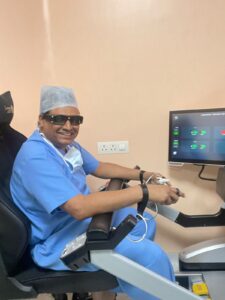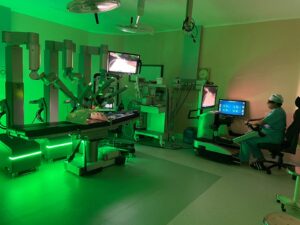Dr. Abhijit Gotkhinde – Laparascopic And Robotic Surgeon in Pune
What is Robotic Hernia Surgery?
Robotic hernia surgery is a minimally invasive procedure used to repair hernias. A hernia occurs when an organ or tissue protrudes through a weak spot in the surrounding muscle or connective tissue. Below is a detailed breakdown of the procedure, its benefits, risks, and recovery process.
During the surgery:
- The surgeon operates using a robotic system controlled from a console.
- Small incisions are made to insert surgical instruments and a laparoscope (a thin tube with a camera).
- The herniated tissue is repositioned, and the weakened area is reinforced, often with surgical mesh.
- This technique is sometimes referred to as robotic-assisted laparoscopy and is particularly useful for complex or recurrent hernias.
Conditions Treated by Robotic Hernia Surgery
- Inguinal Hernia: Tissue protrudes through the inguinal canal in the groin.
- Femoral Hernia: Tissue pushes through the femoral canal, just below the inguinal canal.
- Hiatal Hernia: The stomach bulges through the diaphragm into the chest.
- Incisional Hernia: Tissue protrudes through a previous surgical scar.
- Umbilical Hernia: Intestine pushes through the abdominal wall near the belly button.
- Other Hernias: Flank, epigastric, congenital diaphragmatic, and lumbar hernias.
How Common is Robotic Hernia Repair?
While open surgery has traditionally been the standard for hernia repair, robotic surgery is becoming increasingly popular due to advancements in technology and surgeon expertise. It is now a preferred option for many patients, especially those requiring complex repairs.
Benefits of Robotic Hernia Surgery
- 3D Visualization: Provides a clearer view of the surgical area compared to 2D laparoscopy.
- Precision: Robotic arms offer greater dexterity and range of motion.
- Minimally Invasive: Smaller incisions mean less scarring, pain, and bleeding.
- Faster Recovery: Shorter recovery time compared to open surgery.
Risks and Complications
- Bleeding or infection.
- Injury to nearby tissues or organs.
- Fluid buildup (seroma) or blood collection (hematoma).
- Hernia recurrence.
- Chronic pain (rare but possible).
When to Call Your Doctor
Contact your healthcare provider if you experience:
- Fever or chills.
- Inability to pass gas or stool.
- Pus or redness at the incision site.
- Severe pain or swelling.
- Seek emergency care if you suspect a blood clot (e.g., leg pain, swelling, or redness).
Dr. Abhijit Gotkhinde is a skilled Robotic surgeon who uses advanced robotic tools to perform surgeries. This helps him provide patients with top-quality care using the latest technology.
Robotic Gallbladder Surgery –
Robotic Gallbladder Removal is an advanced, minimally invasive surgery to remove the gallbladder using 3- 4 small cuts & It can be done in single incision. Unlike traditional surgery, which requires multiple incisions, this technique uses a single incision, usually in the belly button, making scars nearly invisible.
How does it work?
– The surgeon makes one small cut near the belly button.
– A tiny camera and robotic surgical instruments are inserted through this incision.
– The surgeon controls the robotic arms from a console, allowing for precise movements.
– The gallbladder is carefully removed, and the incision is closed with stitches.
What are the benefits?
– Less pain compared to traditional surgery.
– Faster recovery and quicker return to daily activities.
– Minimal scarring since only one small cut is made.
– Lower risk of complications with advanced robotic precision.
Who needs this surgery?
Doctors recommend this procedure for people with gallbladder problems, such as gallstones, inflammation, or infection, who need their gallbladder removed.
How long is the recovery?
Most people can go home the same day and resume normal activities within one to two weeks. Following the doctor’s instructions on rest, diet, and physical activity helps in faster healing.
This modern surgical technique makes gallbladder removal safer, easier, and more comfortable for patients. Always consult your doctor to see if this is the right option for you.
Robotic Gallbladder Surgery: A Safe and Advanced Option
Robotic gallbladder surgery is a modern, minimally invasive procedure to remove the gallbladder. It is an alternative to traditional open surgery and laparoscopic surgery. This technique uses robotic technology to assist the surgeon in making precise movements through small incisions.
How Does It Work?
During the procedure:
- The surgeon sits at a console and controls robotic instruments.
- A tiny camera is inserted, providing a high-definition, 3D view of the inside of the abdomen.
- The robotic arms make precise cuts and remove the gallbladder with minimal damage to surrounding tissues.
Benefits of Robotic Gallbladder Surgery
- Smaller incisions – Less scarring compared to open surgery.
- Less pain – Reduced discomfort after surgery.
- Faster recovery – Most patients return to normal activities within a few days.
- Lower risk of complications – Reduced chances of bleeding and infection.
- Better precision – The robotic system allows for greater accuracy in surgery.
Who Needs Robotic Gallbladder Surgery?
This surgery is commonly used for patients with:
- Gallstones causing pain and discomfort.
- Gallbladder infections or inflammation (cholecystitis).
- Gallbladder disease that does not improve with medication.
Recovery After Surgery
- Most patients go home the same day or within 24 hours.
- Mild pain and swelling are common but improve within a few days.
- Most people can return to work and daily activities within a week.
Is Robotic Surgery the Best Option?
Robotic gallbladder surgery is safe and effective, but the best approach depends on your specific case. Your doctor will help determine if this method is right for you. If you are experiencing gallbladder problems, consult Dr. Abhijit Gotkhinde to the best treatment options.




About Dr. Abhijit Gotkhinde – Laparascopic & Robotic Surgery Specialist in Hadapsar, Pune

Dr. Abhijit Gotkhinde
Robotic, Laparoscopic & Laser Surgeon in Pune
MBBS, DNB (GEN SURGERY), FMAS,
FIAGES, Fellow in Adv lap.
Dr. Abhijit Gotkhinde is one of the qualified Robotic, Laparoscopic & Laser Surgeon in Hadapsar, Pune, Maharashtra. He believes in delivering the most authentic and top-class services in Piles, fissures, Fistula Treatments also Hernia Treatments like Epigastric Hernia, Umbilical hernias, Epigastric hernia, Inguinal hernia, Femoral Hernia. He is the best Appendix doctor in Hadapsar, Pune.
He has extensive experience in GI & Colorectal surgeries. He has a special interest in Laparoscopic/Robotic surgery (cholecystectomy, Appendectomy, Hernia, Hysterectomy & Hiatal surgery) and minimal access to proctology surgery. (Piles, fissure & fistula).
Various types of Hernia occur in people. These hernias types include hiatus, incisional, and umbilical hernias. Symptoms are present in about 66% of people with Groin Hernias. So many treatments can be done for various Hernia Treatment within Laparoscopic/Robotic Surgery Treatment. After trying various methods without complete information and knowledge many people fail to achieve the desired Laparoscopic/Robotic Surgery or Laser Surgery for Hernia and Piles Treatment.
